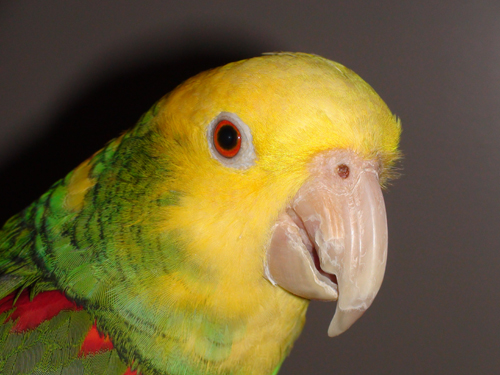The Painted Parrots of Mexico
Ever since the Wild Bird Conservation Act of 1992, the illegal trade of
parrot species into the United States has declined. Of course it still
occurs, but we no longer see the mass movement of parrot species being
brought into the US. Also gone are the days when quarantine stations
throughout Texas, California, Florida and elsewhere are filled with parrots
awaiting passage into the States.
With the success of avicultural breeding programs, many parrot species
have been bred in captivity and are available for sale as pets or to be
placed in zoos, aviaries, etc. This same availability makes it tough
to justify smuggling a bird into the US for sale to the public. After
all, why buy a bird from questionable origins when you can purchase a
healthy, well socialized parrot from a breeder or pet store or adopt a bird from a relinquishment organization?
However, the US is very different from the rest of the world. While
trade of wild caught exotic birds has been significantly reduced in the
US, Europe and Australia, that leaves the rest of the world without
such strict adherence to laws and a more ‘open’ trade of wild birds.
Now to my story….
I recently traveled to Mexico and worked with several avian
veterinarians. The food was fantastic and my hosts were even better.
However, I did see many hospitalized birds that were ill and one in
particular that caught my eye- a frightened red-lored Amazon. In fact
that one bird reminded me of other Amazons with similar issues I have
seen in the Caribbean and in various boarder states. This red-lored
Amazon had been painted to look like a yellow-headed Amazon.
In Mexico, the red-lored (referred to locally as the yellow-cheeked)
Amazon (Amazona autumnalis) is native with its range extending into
northern South America. Red-lored Amazons are currently listed as
CITES (Convention on Trade in Endangered Species) Appendix II and
IUCN (International Union for Conservation of Nature) ‘Least Concern’.
This all means that red-lored Amazons are not currently doomed for
extinction but may if not monitored and trade regulated.
In contrast, the yellow-headed Amazon (Amazona oratrix), also known as the yellow-headed parrot and double yellow-headed Amazon is endangered, is mostly gone from it’s former range in Mexico and currently resides in limited areas in Mexico and Central America. The yellow-headed Amazon is a CITES Appendix I and IUCN ‘Endangered’ species meaning all trade of wild caught species is illegal and the wild population is rapidly declining. While we commonly see yellow-headed Amazons as pets, this bird is in trouble in the wild!
So how do you sell the public an endangered bird without actually
having such an animal? You take a more common species (like a
red-lored Amazon) and dye or paint its feathers on top of the head to
make it look more like a yellow-headed Amazon. Of course the altered
red-lored Amazon is smaller and the paint job is never quite right, but to the
unsuspecting person, they now own a rare and endangered bird (at least
until new feathers grow in).
You can imagine the new ‘hairdo’ is not appreciated as these birds are
colored unwillingly to the point that every one I have seen has been
terrified of people. By the time the proud owner figures out this is
not an endangered yellow-headed Amazon, the seller is long gone and the
psychological damage has been done to the altered bird.
Imposter red-lored Amazons are no less a bird than their yellow-headed
cousins. In fact, red-lored Amazons are beautiful, intelligent and
make great companions- assuming they have not been violated by people.
That is really the problem I have- the trauma these poor birds go
through to become something they are not. All for the purpose to make
a buck. It is situations like this that give animal trade and
ownership a black eye.
The red-lored Amazon I visited in the hospital is being treated
appropriately for his unrelated illness. However, the shock this bird
went through to ultimately end up in veterinary care will likely not
soon, if ever, be forgotten.
Maybe through awareness and conversation, someone will think twice
about buying one of these painted birds. Or better, not traumatize and
paint the bird at all…..



I think I might have encountered a similar problem with a parrot sold to me, where the red would go he is constantly scratching and has removed some feathers from that area, I dont undrstand why the would dye his feathers, asi I wouldnt mind having him be a red lored, he was sold as a mealy amazon but now with 3.5 months old I think he might be a red lored. When you observed this bird, did it remove the dyed feathers by scratching? Withounght having to wait for the next moldint, how do you know if he has been dyed? All I want is a healthy parrot, not matter what kind of amazonhe actually is.
Help is apreciated,
MQG
Mario,
Both red lored and mealy Amazon parrots are classified as ‘Least Concern’ according to IUCN conservation status. Yellow headed Amazons are considered ‘Endangered’ which inherently makes them more valuable to some people. So the more common and less endangered birds are painted to resemble ‘endangered’ and theoretically more valuable species. Generally the paint comes off when they molt or lose their feathers. If your bird is constantly scratching, then I strongly recommend having him examined (ideally) by an avian veterinarian. And you are right, red lored Amazons are wonderful birds! It is a shame that someone would trap and paint the bird just to make it look like an endangered bird!
Sincerely,
M. Scott Echols, DVM, Dipl ABVP (Avian Practice)